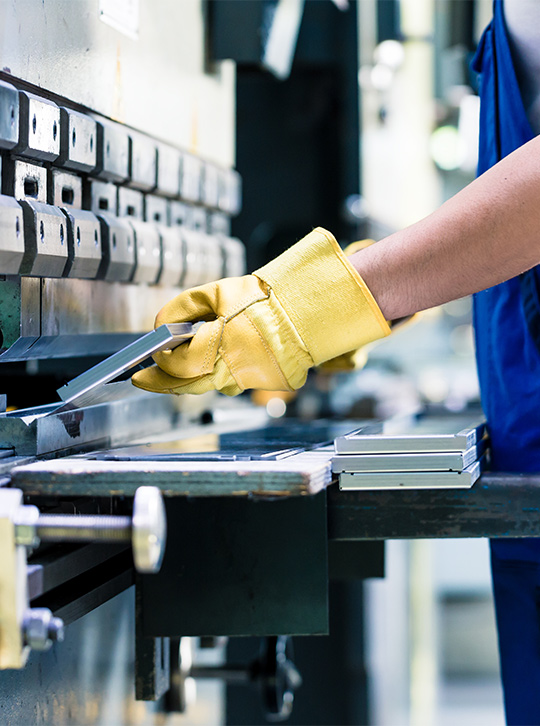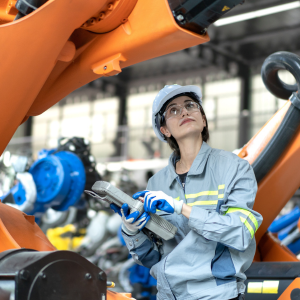What Does Right to Repair Mean for Manufacturers?
Post By: Ryan King On: 27-07-2021 - Industry 4.0 - Industry Trends - Manufacturing
Right to Repair groups have been forming over the past ten years in a bid to change the traditional manufacturing policy of built-in obsolescence, and to combat environmental destruction. The movement is particularly aimed at reducing the 53 million tonnes of e-waste that are produced globally every year, of which 1.5 million tonnes comes out of the UK. The Restart Project has been active as an advocate for the movement in the UK since 2013, and cofounded the Right to Repair Europe group in the EU. The Repair Association in America has helped to push legislation in at least 20 states over a similar period. This advocacy resulted in new EU measures promoting product repairability being introduced in March 2021. Matching standards were launched by the UK government in July 2021.
What Is Right To Repair?
Instead of being obliged by original equipment manufacturers (OEMs) to buy and keep on buying brand new products, Right to Repair supporters want to buy devices that can be repaired or upgraded. This would apply to all aspects of an electrical or electronic device, including not only the hardware but also the batteries, memory and processing power. The Right to Repair movement objectives are broadly:
- That OEMs make repairable products
- That OEMs make parts available that can be used for repairing products
- That OEMs provide repair information with new products, e.g. manuals or guides
The EU is requiring OEMs of consumer electronics to ensure that their products will last at least ten years, instead of deliberately limiting their lifespan in order to increase profit margins. Tools and information must be provided for repairing the product, though in many cases this is limited to non-specialist materials.
Right to Repair groups have been forming over the past ten years in a bid to change the traditional manufacturing policy of built-in obsolescence, and to combat environmental destruction. The movement is particularly aimed at reducing the 53 million tonnes of e-waste that are produced globally every year, of which 1.5 million tonnes comes out of the UK. The Restart Project has been active as an advocate for the movement in the UK since 2013, and cofounded the Right to Repair Europe group in the EU. The Repair Association in America has helped to push legislation in at least 20 states over a similar period. This advocacy resulted in new EU measures promoting product repairability being introduced in March 2021. Matching standards were launched by the UK government in July 2021.
What Is Right To Repair?
Instead of being obliged by original equipment manufacturers (OEMs) to buy and keep on buying brand new products, Right to Repair supporters want to buy devices that can be repaired or upgraded. This would apply to all aspects of an electrical or electronic device, including not only the hardware but also the batteries, memory and processing power. The Right to Repair movement objectives are broadly:
- That OEMs make repairable products
- That OEMs make parts available that can be used for repairing products
- That OEMs provide repair information with new products, e.g. manuals or guides
The EU is requiring OEMs of consumer electronics to ensure that their products will last at least ten years, instead of deliberately limiting their lifespan in order to increase profit margins. Tools and information must be provided for repairing the product, though in many cases this is limited to non-specialist materials.

So far, the UK's Right to Repair legislation is minimal, only covering washing machines (including washer-dryers), dishwashers, refrigeration appliances, TVs and other types of electronic display. It also covers several areas of electronics not directly available to the consumer. It does not include communications technology like smartphones and laptops, or 'dry' white goods such as tumble dryers, microwaves, cookers and hobs. More importantly, it doesn't begin to address the issue of Right to Repair in industry, and how this might impact modern smart factories and cities.
Advantages And Disadvantages Of Right To Repair
Inevitably, the movement is encountering opposition from OEMs. They argue that it challenges their intellectual property rights if they are obliged to publish the blueprints and software for their proprietary designs. They also claim that unskilled people carrying out their own repairs are at risk of injury, both to themselves and to the products. Many OEMs, like Apple, demand that only their own personnel repair their equipment, on their premises and using their own parts. The aim is to meet their high quality and performance standards, but clearly, there's a profit motive involved as well. OEM’s biggest concern is the loss of revenue, not only from the service contracts and sale of replacement parts, but from continuing sales of new products if their lifespans are extended.
Advantages For Manufacturers
At first glance, it's hard to envision what advantages there could be for manufacturers in this trend. Their built-to-fail designs were predicated on people buying more, and more often, without any consideration for the environmental impact. In the old model of industrial manufacturing, equipment failure and a lucrative service contract were built into the sales price – especially for products like cars or lifts, where constant repairs are seen as part of the bargain.
When it comes to industry, customers are more interested in avoiding the loss of productivity and revenue that results from equipment downtime. Manufacturers who embrace Industry 4.0 can move towards a new production model that factors in predictive maintenance. IIoT data feedback and analysis will ensure that parts are replaced before they fail. Augmented reality, simulation and digital twinning will also have an increasing role to play in product design. Using this technology, manufacturers will be able to make equipment more repairable by devising and testing more durable components.
Disadvantages For Manufacturers
One of the biggest impacts for OEMs will be on product design and machine capabilities. Having to make things last for at least ten years will mean changes in the way components are machined and fitted, and may also affect the materials used in the product's construction. The drive to conserve precious natural resources has already inspired some OEMs to look for alternatives. This could mean extensive changes in supply chain structure, as well as the layout and operation of factories. A general move towards smart factories and more connected automation means that some OEMs are already changing their production structure, but major changes require large and confident investment.
OEMs will also be obliged to focus on materials that can withstand 10 years of use without their form and function deteriorating. They’ll also need to be able to store spares for a range of equipment. If parts are expected to last 10 years as well, they may be in storage for the 10 years of the equipment lifetime before their own lifespan begins. Metal structures will have a greater chance of withstanding this doubled life expectancy, but plastics and electronics may well suffer from plasticiser evaporation, oxidation, and other harmful processes. Connectors and relays, for example, can oxidise, which will cause them to supply greater electrical resistance. The electrolytic fluid used in capacitors is prone to dissolve and evaporate over time, limiting their shelf life.
Not least, Right to Repair challenges manufacturers' traditional product ownership, with both product replacement and service approaches having to be reworked. For organisations selling end-user outcomes rather than products, Right to Repair could potentially undermine their built-in service structure and jeopardise their control of such outcomes. For companies whose product servicing is done through software patches via remote portals, Right to Repair can infringe on their intellectual property rights regarding the code – and its accuracy and validity if anyone but their own engineers tinkers with it. It could also stimulate growth in third-party fixers, putting OEMs own service teams out to grass, or requiring a licensing structure for OEMs to approve such third parties.
Advantages For Consumers
Manufacturers of IIoT and connected equipment can supply software fixes via cloud-based service solutions. This would help many customers struggling with control issues for automated equipment. Automotive and agricultural machinery is increasingly produced with computer-controlled programming which can easily be serviced from a distance. The same could apply to energy networks and transport systems. Based on the feedback from IIoT devices, the Right to Repair legislation may also mean that manufacturers can improve their initial designs to factor out points of vulnerability, so that equipment doesn't fail in the same way so often.
Several OEMs have already adapted their service protocols, increasing efficiency through digitally-led practices that improve repair accuracy and service times, thus minimising downtime. Many have also set up self-service portals so that end-users themselves can more easily complete minor maintenance jobs.
Disadvantages For Consumers
It's important to recognise that the USP of field service teams is their product expertise, which is why Apple guard their service operation so jealously. In sensitive environments such as pharmaceuticals and healthcare, it's critical that access to medical equipment is only granted to certified technicians, to ensure patient safety. For electronic goods relying on data and connectivity, consumers being able to fix their own devices also increases the cybersecurity risks. If electronics manufacturers have to hand consumers sensitive data like diagnostic codes, this provides a greater opportunity for hackers to acquire it.
The safety risks extend to other areas of DIY repairs, including any guarantee that repairs carried out by consumers on their own property will meet the safety standards of qualified service technicians. If parts are not supplied by the OEM, but purchased instead from unlicensed third parties, quality and safety may well be compromised. Consumers will have to be provided with information about purchasing and installing parts safely, as well as how to recognise and avoid third-party distributors for whom quality and safety are not a concern.
What Does Right To Repair Mean For Manufacturers?
The challenge for manufacturers is that they have to implement solutions now in order to comply with EU and UK legislation. Corporations and international OEMs should also expect similar legislation to be enacted in the US and elsewhere, making compliance a complex technical challenge. Changes in traditional design and development approaches may cause validation costs to multiply.
Makers and providers of industrial devices – like lifts and tractors, for example – should begin to see how improved access to very detailed operational data and big data analysis will help them to understand better how their own products work. Together with predictive maintenance, specific tasks can be scheduled at optimal intervals, allowing engineers to make their service visits more efficient. Manufacturers with the vision to adopt new business models and processes to optimise their service structure will find their revenues improving. They'll increase their operational efficiency and enhance their overall customer experience.
Get More From Rowse Straight To Your Inbox




